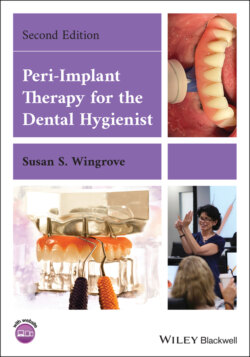Читать книгу Peri-Implant Therapy for the Dental Hygienist - Susan S. Wingrove - Страница 10
Foreword
ОглавлениеDental implants are a viable option for natural tooth replacement with predictable long‐term survival rates. Implant survival alone is an inadequate predictor of success according to modern standards. Careful implant position, prosthetic design, and soft‐tissue management can result in superior aesthetic and functional outcomes. Preservation of peri‐implant soft tissues, optimal function and aesthetics, and implant survival has become the parameters that define success. As such, the partnership of the implant surgeon, restorative dentist, and dental hygienist is essential to preserve these outcomes.
The success of an implant‐supported restoration is promoted by a prosthetically driven treatment plan. The days of placing implants where the bone is, without consideration for tooth position or the planned prosthesis, are long gone. Implant position is ideally determined by the position of the teeth and by the type of prosthesis to be planned. Moreover, the amount of vertical space required for the planned prosthesis must be assessed prior to implant placement. Modern technology facilitates this planning; CBCT machines allow accurate 3‐D visualization of patients' anatomy, proposed implant positions, and the prosthesis. Surgical guides can be fabricated quickly and economically using 3‐D printing or with CAD/CAM technology. Although this technology is used routinely in planning dental implants, it is critical that the implant surgeon utilizes this technology correctly for accurate implant placement, especially if an immediate prosthesis is planned. Moreover, meticulous surgical technique is vital for healing and implant survival.
Paying particular attention to prosthetic design will promote a favorable outcome. The number of implants, antero‐posterior spread, implant‐to‐prosthesis ratios, lip support, the condition of the opposing arch, and functional requirements are considerations when planning an implant prosthesis. An important and sometimes overlooked consideration is the cleanability of the final prosthesis. Creating a prosthesis that harmonizes function, aesthetics, respect for biology, and cleanability should be the primary objective when planning and carrying out fixed and removable implant therapies. If tooth position, function, implant positions, and/or lip support results in a fixed prosthesis that is not conducive to proper and complete oral hygiene practices, a different prosthetic design must be considered.
The necessity for complete and responsible implant maintenance transcends the traditional goal of calculus removal. Oral biofilm is not only responsible for localized and generalized dental, periodontal, and implant disease but is also implicated in the exacerbation of many systemic conditions, including, but not limited to cardiovascular disease, metabolic imbalances, rheumatoid arthritis, and Alzheimer's disease. Complete biofilm disruption has been shown to promote a favorable oral environment and to reduce the risk of the oral contribution to systemic disease. Technology is available to facilitate efficient and effective biofilm disruption in a way that is safe for dental implants. Conversely, there are instruments and medicaments that can be damaging to dental implant surfaces and prosthetic materials and can compromise longevity. The titanium surface on dental implants has been proven to be biocompatible and corrosion‐resistant, but common preventive practices have been implicated in its degradation, including topical medicaments to prevent dental caries, a general or local acidic pH and instruments used to remove biofilm, plaque, and calculus. This dissolution, degradation or permanent deformation of the implant surface may contribute to peri‐implant inflammation, bone loss or eventual loss of osseointegration.
Collaboration between the dentist and dental hygienist is fundamental to promote successful long‐term implant outcomes. A restoration that is not only maintainable for the patient but also the dental hygienist will encourage health in the oral environment and peri‐implant tissues. Dental hygienists that have a general understanding about implant restorations, dental materials, and appropriate preventive measures are invaluable. First, the dental hygienist can educate patients about available prostheses and assess the patient's motivation to pursue implant therapy. This can begin a fruitful discussion for the dentist and the patient. In addition, when dental hygienists understand dental materials and basic prosthetic design, they can select the appropriate armamentarium for maintenance appointments and properly educate patients to practice optimal at‐home maintenance.
To provide safe and appropriate care for implant patients, attention to all of the points previously introduced is crucial. Collaboration between the dentist and dental hygienist will produce superior patient care and a satisfying clinical environment. The dental hygienist has a profound responsibility to be equipped with the knowledge, instruments, technology, and materials to successfully contribute to this collaboration. This text is a culmination of decades of research and will educate and ultimately empower the dental hygienist to provide exceptional care for patients considering, undergoing, or have completed implant therapy.
Dr. Pam Maragliano‐Muniz BSDH, DMD, FACP Board‐certified Prosthodontist Chief Editor, Dental Economics Salem, MA, USA
